Story and photographs by Geoffrey Giller ’10
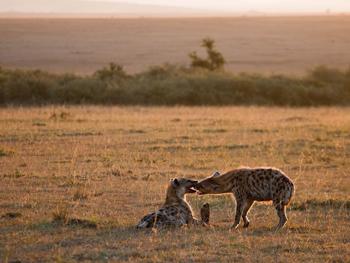 In the early morning light, Magenta (standing) interacts with her sister Taupe over an animal bone.
|
It’s an hour before sunrise. My sole source of light—my headlamp—is aimed at the ground as I carefully make my way to the lab tent, searching for the black lines of biting siafu ants. Stepping on one of these lines means spending the next few hours slapping at sudden jabs of pain all over your body. (There are also black mambas and puff adders to worry about; while their presence in camp is much rarer than that of the siafu, a bite from either would require an emergency airlift.) At the tent I meet my fellow early risers. I check the memory cards in my cameras as we load up, filling mugs with fresh goat’s milk chai and pocketing granola bars to hold us over until our return for breakfast in three hours. This is how my days have started for the past week; for Tracy Montgomery ’10, this is how her days have started for most of the past seven months.
OK, it’s 6:03 a.m. What’s today’s date? The 4th or the 5th? The 5th. It’s March 5, 2011 and we are leaving camp for morning obs. We have TMM … and two guests in the car today.
TMM is Montgomery, who is speaking into a voice recorder; Sarah Skeist ’09 and I are the two guests. We spent two weeks with Montgomery in the Masai Mara National Reserve of Kenya, where she was a research assistant for Dr. Kay Holekamp, a professor of zoology at Michigan State University (and a Smith alumna). From July 2010 to July 2011, Montgomery spent six to eight hours of most days on observations (or “obs”), recording the behavior, interactions and locations of spotted hyenas. This work was part of Holekamp’s multi-decade research project investigating hyena behavior and ecology. Spotted hyenas are unusual among carnivores in that they form well-defined clans with female-dominated hierarchical structures; by the age of 18 months, each hyena within a clan is keenly aware of which hyenas it is dominant or submissive to. “They never make mistakes,” says Holekamp. “You never see them attacking higher-ranking animals.” This rigid social structure, combined with the particular submissive and dominant behaviors that hyenas display, make for a perfect study system for behavioral ecology.
 Hamm, a young West clan male, tries to get at a gazelle carcass, which a leopard has stashed in this tree.
|
In 1987, Holekamp wanted to understand how male spotted hyenas growing up in these complex societies (which are similar to some monkey societies) learned to be subordinate to females. Her study, which she envisioned lasting two to three years, originally had a staff of two: Holekamp and another researcher worked in three small tents beneath two fig trees. Twenty-four years later, Holekamp now has 12 doctoral students and two permanent research camps in the Masai Mara. The camp where Montgomery was based has kitchen, lab and storage tents; nine residential tents; and a small shower, all powered by three solar panel systems. (The word tent may wrongly imply that these structures are temporary. They are double-walled, with thick outer canvases on solid metal frames and tarps across the top. The residential tents even boast full-size bed frames.)
The project has continued to evolve as Holekamp’s findings have raised further questions. For instance, after finding that males don’t become subordinate to females until they leave their natal clans to join other ones, as nearly all male hyenas do around age 3, the researchers began to study the ramifications of changing clans for males. As Holekamp says, “one thing led to the next,” and through the years, she and her students have found that these hyenas provide an ideal model system for studying the evolution of intelligence and maternal effects in mammals. Today, research topics include hyena communication, sampling of the bacteria in scent glands and the effects of different mothering styles on hyena personalities. (Montgomery was involved in a variety of these projects. In addition to her observational duties, she spent time collecting feces and shooting the animals with tranquilizing darts, in order to gather blood and scent gland samples or body measurements.) Along the way, Holekamp and her students have questioned the accuracy of certain “rules” of mammalian biology. “Because [hyenas] appear to violate these rules, these apparent rules, we can, by studying them, figure out what the real rules really are,” Holekamp says. For example, in most mammal species, males are larger and more aggressive than females; the opposite is the case in the hyena clans. And males, “instead of being all macho and big and fierce,” Holekamp says, “are nervous nellies around females” and will line up “peacefully” for mating rights.
In order to study such behavior, researchers must be able to identify individual hyenas. Holekamp keeps pictures of every known hyena in three massive binders in the lab tent. During her first two months on the project, Montgomery spent hours every day memorizing the individual spot patterns. Like giraffes and zebras, no two hyenas have the same markings, but it takes a trained eye to differentiate among them.
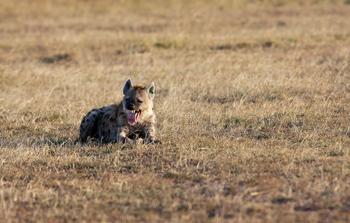 A hyena shows off its impressive teeth. Spotted hyenas have some of the strongest jaws of any terrestrial mammal.
|
“That’s Murphy,” Montgomery says, pointing at an animal in the field. “You can tell because she’s got a big ‘Superman S’ on her left side and three horizontal lines on her right side.” (Each mother’s offspring are named by category. For instance, Scrabble, Parcheesi and Monopoly are part of the “Board Games” lineage, which comprises the progeny of Adonis; Murphy is part of the “Comedians” lineage.) In the field, immediate recognition of each hyena is crucial; time spent looking up an ID means missed behavior observations. In all, Montgomery knows the spot patterns of 200 individual hyenas, 100 of which make up the West clan, the largest clan in the area and the main focus of the research.
We spot the first two hyenas of the morning in the flat gray light before sunrise. They are loping quickly and purposefully with their usual (and bizarre) rocking-horse stride. They seem to have a clear destination in mind: We follow them in a nearly straight line. Soon more hyenas join, all heading in the same direction and all excited, as evidenced by their vocalizations—whoops, squeals, groans and of course their distinctive giggle—and behaviors such as bristle-tail (in which they make their tails erect and bushy) and social-sniffing (in which several hyenas sniff at one particular spot). Montgomery suggests they may be heading to a kill or to a border patrol at the edge of their territory. I check my camera settings in eager anticipation.
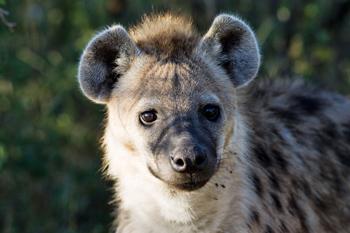 Amazon
|
Just as the sun starts to rise, the animals reach their destination. To my eye, it’s total pandemonium: There are 25 or 30 hyenas giggling, squealing and circling around two lionesses feeding at an unidentifiable, bloody kill. Nearby, an adolescent male lion wanders about nervously, while two small black-backed jackals dart around the edges, hoping to grab a scrap. Montgomery, unfazed, parks the car, raises her binoculars and speaks into her voice recorder.
Adonis and Quinoa just social-sniffed a spot together and now Kyoto is ears-back grinning, sniffing and lifting leg for Quinoa, who also sniffs and lifts leg. Falafel and un-ID-collared hyena are bristle-tailed social-sniffing a spot. Then Honey joins, Alice joins, Siren joins and Fozzie joins. Now all hyenas are orienting towards the bushes. We hear groans and a squeal and we see Centaur emerge [from the] bushes squealing and carpal-crawling to an unID. Gaza whoops, Monopoly whoops…
Montgomery continues to record behaviors in non-stop rapid-fire for the next 15 minutes until the lions, having eaten their share, retreat, leaving the hyenas to descend on the scraps. Holekamp recalls being at another kill with Montgomery, “watching her record behaviors happening very fast and furiously among 25 different hyenas, and she’s able to keep them all straight, and record accurately who’s doing what to whom, and that’s very, very unusual for people to be that good.” Later, Montgomery will transcribe the recordings and add her transcriptions to a database that goes back 24 years. Doctoral students use the database to study various topics—aggression, stress, how social rank affects birth rates.
 Gucci, a West clan female, carries the leg of a gazelle past some of its more fortunate brethren.
|
At first glance, this scene reinforces the stereotype that hyenas are cackling, bullying, brutish animals that drive off the noble lions from their hard-earned kill. But these are not the “awful beast … potential biter-off of your face” hyenas of Hemingway’s Green Hills of Africa, nor the moronic, obsequious hyenas of Disney’s The Lion King. While there is no love lost between hyena and lion out on the Mara, the hyenas are more likely to have killed than to have stolen their latest meal. Hyenas hunt mostly at night, which reinforces their scavenging stereotype: “The African bush is a dangerous place to be wandering around at night, so everybody shuts themselves in,” Holekamp says, “and when they get out there at dawn, they see this nice glorious lion eating a kill. You have to be there earlier to see the hyenas kill this thing and then the lions steal it.”
Because individual hyenas are also more distinct than Disney would have us believe, the urge to personify them is inescapable. “They really were my social circle,” Montgomery says now. “I saw them so often. Especially if they had a kill, you’d just be like, ‘Oh, I can’t believe Gaza took down this animal, and then Juno freaking stole it from him!’ They all had personalities for me.” Montgomery’s favorite? Amazon. “She was really smart. She knew that I was separate from the car; she could tell when I moved versus when this big green thing I was in moved. She came really close to the car. She would come and look up at me, and her nose was right next to the windowsill.” Montgomery remembers another hyena, Gucci, as “a really strong mother,” smart enough to quickly unlatch “the puzzle box,” an intelligence test that requires the animals to open a cast-iron box with food inside. And Montgomery remembers exactly how she felt when Murphy died in April 2011. “It was really embarrassing, but I totally cried,” she says. “West was Murphy.” Murphy, whom researchers nicknamed “the Queen,” was the alpha female of the West clan for 12 years until she was killed by lions that had cornered her and Fozzie, her constant companion.
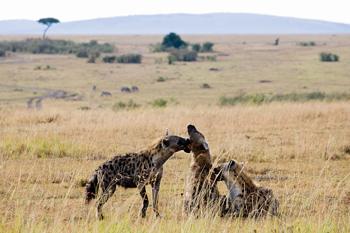 Play-fighting, from left, are Siren, Amazon and Magenta
|
Losing Murphy was like losing a monarch. As such, it brought up the question of ascendancy. As in some monkey species, the youngest daughter of the previous alpha member ascends first; this makes it more likely that each alpha female will “reign” for a long time, thus strengthening the clan’s stability. Murphy had a three-month-old cub, but this cub vanished from the den soon after its mother’s death. This left Loki and Juno, twin daughters about 4 years old. But which was dominant? After two months of observations, Montgomery finally saw Juno and Loki at a carcass; Juno bit Loki, who (in obs-speak) “ears-back open-mouth appeased” and “carpal crawled,” all submissive behaviors. At last, decisive evidence: Juno was the new alpha. Except for one detail: Dionysus, thought to be the younger brother of Juno and Loki, was in fact their younger sister. Nevertheless, with Dionysus “too small and too laid-back” (in Holekamp’s words) to hold her own, Juno became the new queen with a mostly “peaceful” takeover.
Such was not the case after Murphy’s mom, Bracket Shoulder, died in 1999. “There were a number of adult sisters who were all young and all really interested in the job,” Holekamp explains. “There was a lot of fighting and wounding and social unrest for several months before they sorted it all out.” Each of Bracket Shoulder’s numerous offspring allied with either Murphy or her sister Carson, who was one year older. Ultimately, “the kin siding with Murphy outnumbered those siding with her older sister,” says Holekamp. The more I learn about these hyenas, the more I wonder why the people behind Animal Planet’s Meerkat Manor haven’t realized the potential for a similar hyena-based reality show.
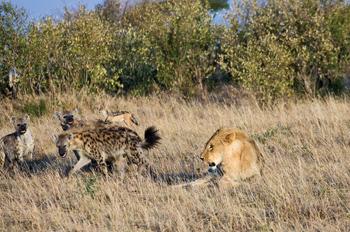 Parcheesi (foreground, demonstrating the bristle-tail behavior) and other hyenas face off against a lion near a kill, as a black-backed jackal darts around the edges of the fray.
|
To those who didn’t know her well, Montgomery came across as shy and unassuming at Amherst. But as her friend since sophomore year, I know that the Ultimate Frisbee team’s “Tracy Montgomery ‘Secretly Awesome All the Time’ Award” is aptly titled. “You don’t very often get somebody who’s that conscientious in their field work and that careful in the data collection who’s also just a lot of fun to be with,” says Holekamp. “Tracy’s one of the best research assistants I’ve ever had.” Professor Ethan Clotfelter, her thesis adviser at Amherst, appreciated Montgomery’s ability to “bounce back from the little speed bumps that you hit when you’re doing research.” As he says, Montgomery is “the one who gets up in the morning and is excited about tackling the projects of the day.”
Montgomery’s interest in hyenas began, indirectly, with her biology thesis at Amherst. “Ethan taught me so much about what ‘research’ actually is,” she says. Though her thesis focused on endocrine disruptors in fish, Clotfelter’s “Animal Behavior” class piqued her interest. By the end of her senior year, she knew she wanted a job involving animal behavior and fieldwork. As she puts it, “What could be cooler than studying hyenas in Africa?” She remembers just one qualm about spending a year in the African bush: “I was probably nervous about the spiders. I really don’t like spiders.” (During the year, she killed three black widow spiders in her tent.)
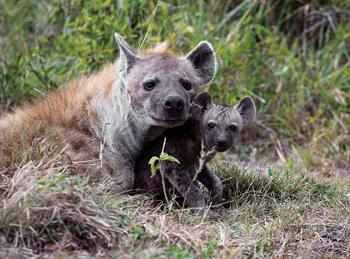
A mother hyena leans protectively over her young, curious cub.
|
Montgomery is not the first or even the second to follow this path from Amherst to Kenya. Leslie Curren ’05 and Kate Shaw ’05 are both Ph.D. students in Holekamp’s lab. Curren and Shaw were lab partners in Clotfelter’s “Animal Behavior” class; like Montgomery, Curren did her thesis with Clotfelter. She now studies competition and cooperation among male hyenas, while Shaw studies the consistency of certain “personality” traits and looks at how those traits affect survival and reproduction. Since returning to the States, Montgomery has observed marine mammals for two separate projects. But she is probably not finished with the hyenas: She plans to apply next year to be a doctoral student in Holekamp’s lab.
After the encounter with the lions, we watch the hyenas disperse, and we drive back to camp. We spend the middle of the day doing chores; observations during these hours would be uneventful, as most animals in the Mara simply seek shade and “sack out.” Today is inventory day, which is about as exciting as it sounds. But I’m happy to help, since I’m being put up and essentially taken on safari daily. Besides inventory, Montgomery uses this time of day to take care of other responsibilities around camp: checking liquid nitrogen levels to keep samples cold, getting gas and water, and inspecting vehicles and solar panels.
 Montgomery leans out of the car for a quick shot with a sleeping lion.
|
After inventory and a nap, we head back out for evening observations. Tonight Montgomery is using the radio tracker to look for the Fig Tree clan, which has been “missing” for several weeks. (The Mara is a big place.) Soon, however, storm clouds roll in, putting an early end to our search while providing a fantastic lightning show. Montgomery and I attempt to brave the rain by riding in the bed of the truck, but we last only five minutes. Back at camp for dinner, we eat ugali, a Masai dish made from cornmeal, and we spot the small, catlike genet that sometimes hangs around the edge of the tent. We play a few rounds of cards before retiring to our tents by 9:30. (A 4:50 a.m. alarm necessitates an early bedtime.) After backing up my photos from the day and doing a quick snake-check under the sheets, I turn out the light and savor the total darkness. Besides the solar panels, there is no source of electricity for miles. For a few minutes, I listen to the cacophony around my tent—squeaks, rustlings, squawks and the persistent, electronic chirp of fruit bats. Yet despite it all, I have no trouble falling asleep. Somehow, the walls of my tent seem sufficient to keep me safe from the rest of the Masai Mara until we venture out again tomorrow morning.
Geoffrey Giller ’10 worked as a student photographer in the Amherst Office of Public Affairs while majoring in biology and French. He is now earning a master’s in environmental science at Yale.
Many more photos are in his Flickr gallery. He also made a video from the 3,700 photos he took while on the trip.